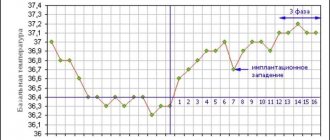How the test works
The test looks for a hormone called human chorionic gonadotropin (hCG). It is produced by a woman's body after fertilization. The substance is synthesized in the membrane of the fertilized egg, starting from the moment when the egg attaches to the uterus after fertilization. Since this happens 7 days after conception, pregnancy can be determined from this moment.
If the woman is not pregnant, hCG is also produced, but its concentration does not exceed 5 mIU/ml. When pregnancy occurs, the hormone levels increase rapidly. For example, after a week it reaches 10 mIU/ml, and a month after conception – 151,000 mIU/ml.
December 24, 2017
There are two lines on the test, but there is no pregnancy: does this happen?
The onset of pregnancy can be either a long-awaited or a very unexpected event in the life of a woman or family. At the moment when a woman begins to suspect her “interesting situation” or cannot associate the appearance of new characteristic symptoms with anything else, a pregnancy test comes to the rescue. This simple, but at the same time very convenient invention “works” quite accurately. The probability of an erroneous result if the test is carried out in a timely manner does not exceed 1%. Moreover, the test can be both false negative and false positive. Today we will talk about those situations when the test shows a positive answer, although the woman is not pregnant. Why does this happen sometimes?
How does a pregnancy test work?
To understand why a pregnancy test may show a false result, it is important to understand how it works. Before performing the test, you must read the instructions for use. The procedure is very simple: lower the test strip with a certain end into a container with urine or place it under a stream of urine, then evaluate the test after a specified time.
The appearance of two lines on the test will indicate a positive result, that is, an existing pregnancy. This is magic? Or how to explain such an amazing phenomenon that a narrow test strip can notify an expectant mother about the upcoming addition to the family before the doctor?
What is HCG?
No, there is no magic in a pregnancy test. Simple chemistry. The test strip contains a chemical indicator that reacts with human chorionic gonadotropin (hCG). This is one of the earliest pregnancy hormones, which is secreted by chorionic villi (the future placenta). Its release begins from the moment the fertilized egg attaches to the uterine wall and continues throughout the pregnancy. It can be detected in the blood or urine of the expectant mother. A pregnancy test is based specifically on the detection of hCG in the mother's urine.
It is recommended to carry out the test no earlier than the first day of the missed period or approximately two weeks from the expected day of conception if the woman has an irregular cycle.
Why are pregnancy tests false positive?
Women react differently to the two lines that appear on the test, because for some, pregnancy is a cherished dream, for others it is an unpleasant surprise. In any case, a positive test result is only the initial step in diagnosing pregnancy.
By the way, the test result is not always expressed by the number of stripes. Sometimes the signs “+” or “─” appear, sometimes the words “pregnant” or “not pregnant”, “Yes” or “No”. This does not change the essence of the matter, because any pregnancy test only reflects the amount of hCG in the urine of the test subject.
However, it happens that the test strip shows a positive result in the absence of pregnancy. Why? Let's look at the most common reasons for a false positive response during a pregnancy test.
Postpartum period
The level of hCG increases in the bloodstream and in the urine of the expectant mother from the first days of pregnancy, reaching its maximum in the third month of gestation (7-11 weeks). After reaching this period, the hormone level gradually decreases. However, the test remains positive throughout the entire period of pregnancy and even for some time after its end (on average 3 weeks).
That is, there is no need to panic if, after a recent birth, the test shows two stripes. This does not mean that the woman will soon become a mother again. It just takes time for the hCG levels to drop. However, we must not forget about reliable contraception even in the first months after childbirth, if the family does not plan to have similar children.
Recent miscarriage or abortion
After spontaneous termination of pregnancy (frozen pregnancy, miscarriage) or abortion, the hCG level also does not decrease immediately. This period can last from 9 to 35 days (on average about 3 weeks). Accordingly, a pregnancy test taken in a given time period may turn out to be positive if there is no embryo in the uterus at the time of the test. The test will take a particularly long time to be positive if there are remains of placental tissue in the uterine cavity.
If there is any doubt about the presence of pregnancy, a woman should donate blood to check the hCG level (this is not only a qualitative, but also a quantitative analysis) and/or have an ultrasound of the pelvic organs. This will allow you to understand whether there is a pregnancy, or whether the test reflects the presence of hCG from a pregnancy that was very recent.
Hydatidiform mole
Women know very little about this disease or have never even heard of it, but obstetrician-gynecologists are very afraid of it. What is a hydatidiform mole? This is one of the most serious pathologies of pregnancy, in which the chorionic villi (placenta) change pathologically. Young women are more likely to get sick. The causes of this condition have not yet been fully established.
With hydatidiform mole, bubble-like expansions are formed along the chorionic villi. There are different forms of hydatidiform mole. Normal development of the fetus with this development of events is in most cases impossible, it dies. The disease itself is very serious and can even threaten the patient’s life. Removing a hydatidiform mole is the only way to treat a woman.
A pregnancy test during the development of a hydatidiform mole is always positive. Even the uterus increases in size because the chorionic villi grow like bunches of grapes. Ultrasound examination of the uterus is of decisive importance in the diagnosis of hydatidiform mole.
Chorionepithelioma (chorionic carcinoma)
This is a malignant tumor of the trophoblast (that is, the chorionic villi or placenta). Chorionepithelioma can be a consequence of hydatidiform mole, as well as an independent disease. It happens both in pregnant women and in women in the postpartum period.
The tumor quickly metastasizes, forming foci in various internal organs. Since the tumor is based on trophoblast tissue, a large amount of hCG is produced, as a result of which the pregnancy test will be positive. The disease is very serious, the prognosis is serious.
Superovulation in preparation for IVF
Some women dream of having a baby so much that they take pregnancy tests even when they are not needed, for example, when preparing for in vitro fertilization (IVF). During the period of taking medications for superovulation, a large amount of hCG is produced in the ovaries, which will certainly be shown by a positive test result, although pregnancy is still far away. Doctors should inform the patient about this in advance so that she does not make hasty conclusions that she was able to get pregnant on her own.
Tumors of internal organs
All of the above reasons for a false-positive pregnancy test are still related to pregnancy, even one that has recently ended or has not yet occurred. But it also happens that a positive test has nothing to do with pregnancy. We are talking about tumor processes in internal organs, in which the tumor produces hCG. This happens with tumors of the ovaries, brain, lung, stomach, breast cancer, etc.
As a rule, a woman finds out about existing malignant tumors in other ways, and not through a positive pregnancy test. Still, a pregnancy test is usually done when menstruation is late, while cycle failure in the presence of tumors is not at all necessary.
Technical violations during the test
It very rarely happens that a woman has a low-quality test in her hands, which gives a false positive result. However, knowing that this happens, many women deliberately take several pregnancy tests from different companies. Repeated test failure is unlikely. In addition, when conducting the test, you must strictly record the time allotted for interpreting the result. Usually it is 3-5 minutes.
By the way, it’s not bad if the test is also evaluated by another person (girlfriend, spouse). It happens that a woman simply imagines the desired stripe, while in reality it is not there.
What to do if you have doubts about a pregnancy test?
It happens that a woman doubts the correctness of the test. For example, the test shows a positive answer, although there are no other signs of pregnancy. Or there is menstrual-like discharge, although the test indicates pregnancy. Or in a situation where two tests showed different results? What to do?
- First: there is no need to try to find the truth on your own. The most correct thing is to consult an obstetrician-gynecologist. It is he who will decide what needs to be done first: donate blood from a vein for hCG, do an ultrasound of the uterus and ovaries, or simply examine the patient in a chair.
- Second: do not try to get rid of pregnancy (which has not yet been confirmed) in out-of-hospital conditions. Frightened by an unplanned pregnancy, some women resort to criminal abortions or simply take the “needed pill” at home. This is fraught with serious complications for life and health. The pregnancy must first be confirmed, and then the issue must be decided together with the doctor about how to terminate it, if such a desire arises.
- Third: try to “get to the bottom” of the truth. Lack of pregnancy is not a reason to relax. We need to find the reason why the test became positive. In some cases, the reason lies in serious cancer and endocrine disorders, which require not only diagnosis, but also timely treatment.
← Back
Main types of pregnancy tests
Today, several types of tests have been developed with varying degrees of sensitivity. The study can be carried out in a clinical or home setting. So, in pharmacies you can buy the following types of tests:
- Strip test (stip test) is the simplest type. Allows reliable diagnostics from the first day after the delay. It works simply and quickly - dip the strip into the urine and after a few minutes look at the result: 2 strips - “yes”, 1 strip - “no”. At the same time, the accuracy is low, and failures are often observed.
- Tablet test - the principle of operation is exactly the same. However, the accuracy is higher. This also affects the price - the tablet costs more than a regular strip.
- The inkjet test is a very reliable test, providing an accuracy of about 99.8%. The name is associated with the peculiarities of the study - the strip is placed under a stream of urine.
- A digital test is another precise type of research. It gives an almost instantaneous result, which is displayed on the screen of a digital device as a “+” (confirmation) or “-” (negation) icon. Along with this, the device calculates the gestational age. The only drawback of this type of test is the high price.
Can I use tests to monitor the dynamics of hCG growth?
The dynamics of hCG growth in the early stages of pregnancy is considered one of the most important prognostic signs. A steady increase in hormone levels indicates that pregnancy is progressing. Low growth almost always indicates problems: a non-developing pregnancy, and possibly an ectopic pregnancy.
Theoretically, pregnancy tests from the same manufacturer and, preferably, from the same series are capable of demonstrating dynamic changes. But in practice they can contain different amounts of the reagent, which affects the brightness of the strip. The purpose of the test is to answer the question: is there a pregnancy or not. And to determine the growth rate of hCG, you need to donate blood, and not suffer from testomania
When is the right time to take the test?
The earliest time for diagnosis is 8 days after the expected conception. At this point, you can only use a laboratory blood test, since all other methods will probably give an inaccurate result.
As for the pharmacy test, it is used a little later:
- 1-2 days after a missed period;
- 2 weeks after the expected conception.
However, it is not recommended to rush. The strips are most accurate 7 days after the delay. It is at this time that you can find out the correct result with a probability close to 100%.
Be sure to follow the rules
Before using the test, check that its packaging is not damaged and the expiration date of the product is normal. Remember that the test should be stored in dry and dark places. Exposure to direct sunlight, as well as high humidity, can reduce the accuracy of the study. In addition, when performing the test, you should strictly follow the instructions. For example, you need to lower the strip into the urine to a certain point and strictly for a specified number of seconds. If you do not see a single strip appearing on the control surface, then the product is damaged, you should purchase another test and repeat the procedure.
How to use the test
The instructions are quite simple:
- Determine the timing of the analysis.
- Purchase a test and a clean jar for collecting urine from the pharmacy.
- Collect urine in the morning (it is at this time that the concentration of hCG is maximum).
- Immerse the strip for 15 seconds.
- Remove and place on a clean dish or other surface.
- Wait up to 5 minutes.
- Determine how many stripes are colored.
There may also be other instructions. For example, in the case of a jet test, the strip is not immersed in the collected urine, but is placed under the stream directly during emission. If the digital version is used, the strip is inserted into the device, which displays the results on a liquid crystal screen.
To interpret the results, you can use the following rules:
- If only one stripe is colored, pregnancy is not confirmed.
- If 2 stripes are colored, the fact of pregnancy has been established.
- If there are none, the test is expired or defective.
It may also turn out that the second strip is visible, but rather weakly. This indicates a low concentration of the hormone. Perhaps the test was done too early or it was not sensitive enough. There may be other reasons - chronic diseases, early miscarriage, recent abortion, taking drugs to enhance fertility.
In such cases, it is necessary to do another test, but not the next day, but after 2-3 days. If the second strip is faintly colored again, it is recommended to consult a doctor and perform an ultrasound of the uterus.
Which test is the most accurate? The one that is the most expensive?
When trying to determine the accuracy of a pregnancy test, it is better to look not at the price tag, but at the packaging. It indicates the sensitivity of the test: the higher it is, the sooner the test will be able to determine the content of hCG in the urine. Most often, the sensitivity of tests is 20–25 mIU/ml. For more “advanced” models, 10 mIU of hCG in 1 ml is sufficient for a positive response. At the same time, a more sensitive test strip costs much less than a less “fast” inkjet test. And the sensitivity of the most expensive electronic tests is most often the same as that of the “simples” (20–25 mIU/ml). The only difference between them is that the results are processed by a special program, and not by women, who can sometimes “see” the strip even on a crystal-white surface.
Early signs of pregnancy
When a woman becomes pregnant, the so-called restructuring begins in her body in order to successfully bear and give birth to a child. All changes during this period, even before the delay of menstruation, have their own signs.
These include:
- Minor spotting approximately 6-12 days after intercourse
- Frequent and painful urination
- Increased appetite
- Cold symptoms are often felt, that is, headaches, fatigue, fever, malaise.
- Lower blood pressure
- Sensitivity of the mammary glands, perhaps they swell a little or become painful.
A feeling of fullness in the lower abdomen, this may be due to the fact that during pregnancy, blood flow to the pelvic area increases and the uterus becomes larger.
- Increased sensitivity to odors
- Nausea
- Dizziness
Indirect signs
Often, most women do not notice the onset of pregnancy and the beginning of life. Only after a new menstrual cycle does not occur do girls begin to suspect something. Doctors say that a delay in menstruation is the very first sign, but still indirect. After all, a delay can occur due to hormonal imbalances, inflammatory processes or other reasons.
Ectopic pregnancy
Sometimes an ectopic pregnancy occurs, in which the baby develops outside the uterus. This may be due to inflammation, congenital or acquired pathologies of the fallopian tubes, or hormonal disorders. Unfortunately, it is impossible to save the child.
It is extremely important to identify the pathology in the early stages; otherwise, the woman’s life will be at risk. At the initial stages, it is no different from the usual one, but in the future, the development of the fertilized egg in the wrong place will lead to intra-abdominal bleeding and urgent surgery will be required.
Blood test for hCG
In addition to home tests, doctors recommend taking a blood test. It is more informative, since the concentration of the hormone in the blood is several times higher than in the urine. The test can detect pregnancy earlier than urine tests, but it takes longer to complete.
There are 2 main types of blood tests for hCG:
- qualitative. Answers the question: is the hormone level elevated or not, which indirectly suggests the presence or absence of pregnancy in a woman;
- quantitative (beta-hCG). This analysis reflects the exact concentration of the substance in the blood, so the doctor can monitor hormonal changes over time.
To obtain correct blood test results, you must adhere to the following rules:
- the analysis is performed strictly on an empty stomach in the morning;
- 12 hours before the test, alcohol consumption, physical activity, and smoking should be completely avoided;
- In the morning on the day of analysis, drinking water is allowed;
- It is necessary to avoid taking any medications. If this is not possible, you need to notify the laboratory and doctor.
Determining pregnancy is not the only task of a blood test for hCG. As noted earlier, during the formation and development of the embryo, the level of the hormone in a woman’s body should gradually increase - up to the 12-13th week of pregnancy. If, with regular observation, an increase in hCG is not observed or the hormone level does not correspond to generally accepted standard values for a specific period, then this may indicate the development of a frozen or ectopic pregnancy, with a high probability of miscarriage.
At later stages, quantitative determination of hCG can be used as a screening for genetic disorders in the fetus (Down or Edwards syndrome). The determination of beta-hCG also plays an important role. If a woman’s level of this hormone is elevated, but other characteristic signs of pregnancy are not observed, tumor diseases should be suspected.









